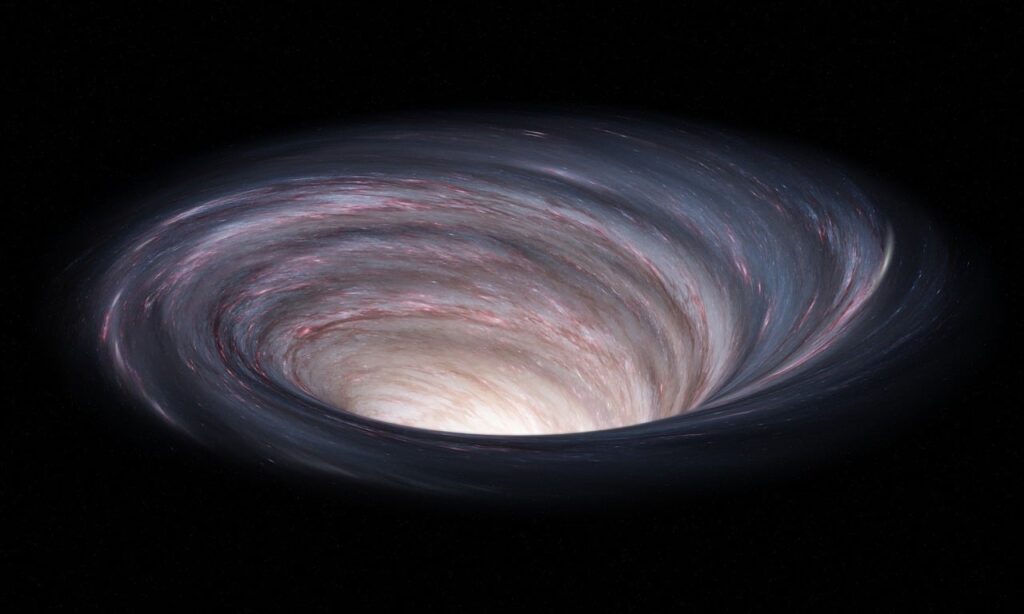Today’s blog

Lynn Murphy Mark
Meanwhile, in a neighboring galaxy…
It’s Saturday morning and I don’t need to be anywhere for a few more hours. I took my time browsing articles of interest and was immediately captured by one about a phenomenon happening in the galaxy right next to ours.
Having worked in health care for a long time I am used to acronyms, but this morning I was introduced to a handful of astrophysics wordplays and a space moniker, an Accretion Disc.
The author of the research study is Anna McLeod from the University of North Carolina, in Durham, NC. She wrote, “We know discs are vital to forming stars and planets in our galaxy, and here, for the first time, we’re seeing direct evidence for this in another galaxy.” She is part of a team using ALMA (Atacama Large Millimeter/submillimeter Array), a massive collection of 66 antennas in Northern Chile forming a single radio telescope. With this technology, the team was able to peek into a galaxy a hundred thousand light years away from earth.
Apparently the Milky Way is also a source of the creation of new heavenly bodies, but the key to this study is the discovery of a similar occurrence at such an incredible distance. An “Accretion Disk” is a collection of diffuse materials orbiting a huge central object that is often a star or planet in the making. This very thing happened about 4.5 billion years ago when our own planet underwent the transformation of dust and gas into a solid object. The body whose mass is growing is known as the accretor. You could say we are living on an ancient accretor.
Our neighbor is named the Large Magellanic Cloud. Scientists have begun to visit it using a MUSE (Multiunit Spectroscopic Explorer), another massive telescope. My favorite acronym, much more my speed, is VLT (Very Large Telescope).
As I read through the article I was fascinated by the information, new to me, about how a star is born. I thought about the Bible story of earth’s creation in seven days against a process that must take a very long time. An article from the American Museum of Natural History puts forward two positions – one that it takes 10 million years for a star’s formation, and another that believes it happens in only a few million years. Mind blown.
Here I am, right at the crossroads of astrophysics and my faith. As I read the words about the magnificence of creation, my faith tells me that God, indeed, is behind it all. Even if I cannot imagine the infinity of the Universe(s), I have no trouble believing in the Power that created it. Learning about light year distances and processes that take millions of years, the numbers are astounding to my limited brain. But this morning I also learned about Father George Coyne, a Jesuit priest and astronomer. When he died, the New York Times referred to him as the “Vatican astronomer and Galileo defender”.
He spent his career insisting that science and religion are comrades. He faced a lot of opposition from the conservative Catholics at the Vatican, but that didn’t slow him down. (It only took the Catholic church until 1992 to formally acknowledge that Galileo should not have been condemned for suggesting that the earth rotates around the sun!). One of the statements Father Coyne made is, “One thing the Bible is not is a scientific textbook. Scripture is made up of myth, of poetry, of history. But it is simply not teaching science.”
In my Unity faith, that is how we view the Bible. It is a masterful collection of spiritual teachings and forms the basis for a metaphysical understanding of Jesus as having the highest level of spiritual consciousness. Unity’s co-founder, Charles Fillmore, viewed the Bible as a spiritual allegory. With this in mind I can interpret the seven days of creation as the best understanding of the time in which it was written. Now that we have ALMA and MUSE and the VLT, we are exposed to the real significance of creation.
